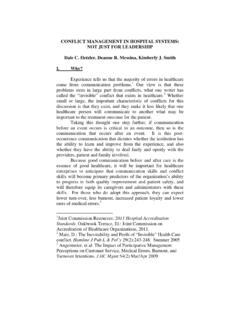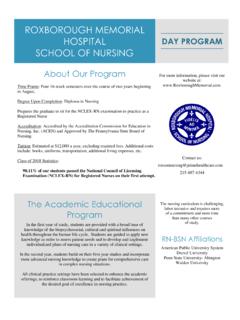Transcription of JCI Handbook Cover - Apollo Hospitals Dhaka
1 JCIA01 CONTENTSWhat is JCI accreditation ?Who are JCI?Benefits of JCIJCI Standards (5th Edition) Chapter Details Purpose and Goal of JCI accreditation InitiativesJCI addresses the following issues very intensivelyAccreditation Participation Requirements (APR)International Patient Safety Goal (IPSG)Access to Care and Continuity of Care (ACC)Patient and Family Rights (PFR)Assessment of Patient (AOP)Care of Patient (COP) Anesthesia and Surgical Care (ASC)Medication Management and Use (MMU)Patient and Family Education (PFE)Quality Improvement and Patient Safety (QPS)Prevention and Control of Infections (PCI)Governance, Leadership and Direction (GLD)Facility Management and Safety (FMS)Staff Qualification and Education (SQE)Management of Information (MOI)JCI Survey Preparedness Guidelines020202030305050607091215203439 424348616272747702 What is JCI accreditation ?Joint Commission International accreditation is a voluntary process in which an entity separate and distinct from the health care organization which assesses the health care organization to determine if it meets a set of requirement (standards) designed to provide a visible commitment by an organization to improve the safety and quality of care which is optimal and achievable.
2 It is an effective quality evaluation and management tool for ensuring a safe care environment which helps continuous improvement process to reduce risk to patient and staffs. Who are JCI?Joint Commission International is a based not for profit accreditation body which sets and designs standards and processes to create a culture of ethics, safety and quality within an organization that strive to continually improve patient care processes and of JCIJ oint Commission International teaches and leads us to: Improve patient trust by improving patient safety, quality and care. Provide a safe and efficient work environment that contributes to staff satisfaction Listen to patients and their families, respect their rights, and involve them in the care process as partners; and Helps establish collaborative leadership that sets priority for and continuous leadership for quality and patient safety at all levels. 03 JCI Standards (5th Edition) accreditation Participation Requirements (APR): 12 Chapters Total Number: 16 Patient Centered Chapters: 8 Organization Management Chapters: 6 Academic Medical Center Hospital Chapters: 2 Standards: Total Number: 304 Standards are set around the important functions; they are common to allhealthcare statement: Easy explanation of the standardsMeasurable Elements: Total number: 1218 Measurable elements are those requirements of standards which arereviewed and assigned a score during : Assesses the Hospitals compliance on JCI standardsChapter DetailsI.
3 accreditation Participation RequirementsAccreditation Participation Requirements (APR)-Introductory04II. The Patient Centered Standards are:1. International Patient Safety Goals (IPSG)2. Access to Care and Continuity of Care (ACC)3. Patient and Family Rights (PFR)4. Assessment of Patients (AOP)5. Care of Patients (COP)6. Anesthesia and Surgical Care (ASC)7. Medication Management and Use (MMU)8. Patient and Family Education (PFE)III. The Organization Management Standards are:9. Quality Improvement and Patient Safety (QPS)10. Prevention and Control of Infections (PCI)11. Governance, Leadership, and Direction (GLD)12. Facility Management and Safety (FMS)13. Staff Qualifications and Education (SQE)14. Management of Information (MOI)IV. The Academic Medical Center Hospital Standards are:15. Medical Professional Education(MPE)16. Human Subjects Research Programs(HRP)(** Please note that section IV is not relevant for AHD)05 Purpose and Goal of JCI accreditation Initiatives The Purpose is to give Apollo Hospitals Dhaka international fame by setting Goals which stimulate demonstration of continuous, sustained improvement in healthcare organization by applying interna-tional consensus standard, International Patient Safety Goals and Data Measurement addresses the following issues very intensively:1.
4 International Patient Safety Goals2. Patient & Family Education3. Patient & Family Rights & Responsibilities4. Pain Management5. Quality Indicators & Monitoring6. Hand Wash & Prevention and Control of Infection7. Fire Safety and Emergency Codes8. Removal of Barriers to Care9. Patient Identifiers10. Care of High Risk Patients (Vulnerable patients)11. Restraint Order12. Rights of Drug administration13. Discharge Planning & Components of Discharge Summary14. Time Out15. Biomedical Waste Disposal16. Personal Protective Equipments (PPE)HIGHLIGHTS 0617. HAZMAT, Lab, Radiation, Facility Safety18. DNR (Do Not Resuscitate) 19. End of Life Care20. Hospital Mandatory Trainings accreditation Participation Requirements (APR): a TRANSPARENT practice : Mandates which are rational for requirements evaluation methods and consequences of non-compliance accreditation process and maintaining an award. TTimely submission of data and informationRReports (within 15 days) of any changes in hospital profile or informationAAccurate and complete information through all phases of accreditationNNotifies the pub lic of concerns about patient safety and care SSubmits accurate representation of accreditation statusPParticipates in Library of MeasuresAAllow JCIs board and staff to observe the onsite surveyRReportingfrom individual concerned about the h os pital w ithout retaliatory action EEndow with patient care in an environment that poses no riskNNotify review of original authenticated results and reportsTTranslation and interpretation service arrange ments during audit days07 CHAPTER ONEINTERNATIONAL PATIENT SAFETY GOAL (IPSG):IPSG 1 IPSG 2 Identify Patients CorrectlyUse two identifiers; Name and UHID for both IPD and OPD.
5 For unknown/ comatose patient brought in ER identify as unknown 1 or 2 Improve Effective Communication(i) Use read back and verify policy for verbal order and laboratory test result obtained on the phone and the process ( for handover communication)(ii) Comply to handover communication policyIPSG 3 Improve the Safety of High-alert lnj. Pottassium Chloride, lnj. Sodium Chloride more than , Inj. Magnesium sulphate equal to or more than 50% are not to be stored in patient ward but stored only in the IP alike and sound alike medications are stored with proper labeling with tallman 4 IPSG 5 IPSG 6 Ensure Correct Site, Correct-Procedure, Correct Patient Surgery Follow pre-surgical site marking with a downwards arrow, pre-operative checklist and time out in OT and Bedside the Risk of Health Care Associated infectionsFollow the WHO 2009 hand hygiene the Risk of Patient Harm Resulting from falls. Safety First Program 09 CHAPTER TWOACCESS TO CARE AND CONTINUITY OF CARE (ACC):Information about the hospital provided to the patients in In Patient Guidebook.
6 Removal of Barriers to care:LanguagePhysicalReligiousA list of interpreters is available on all nursing stations. Wheelchairs/Stretchers are readily available at the entrance. Lifts available for all floors. Handicapped Toilets@ MHC, Emergency DepartmentPrayer Places, are available within the precinct. Spiritual Services are provided when asked for. CulturalDifferent types of food choices are available. Patients needs to observe auspicious time for any procedures are IdentifiersUse at least two patients identifiers (not the patients room number) whenever taking blood samples, administering medications, or blood Coding in Disaster Triage:Red : Most urgent (patient needs to be seen immediately)Yellow : UrgentGreen : Non UrgentBlack : Dead Routine TriageHospital emergency room currently uses a 3-tier triage system. The 3-tier system is based on the following classifications:Level 1 (immediate)Level 2 (very urgent)Level 3 (urgent) They are f or Inpati entsFor Outp atientsFor c omato se p ati ent i nth e e mergency Name UHIDName UHIDU nknown1/2 /3 UHID11 Discharge PlanningDischarge planning is done at the time of admission so that a patient s needs even after discharge can be planned well ahead in time.
7 This improves the quality of patient care and decreases readmissions due to lack of availability of vital equipment at home, after of Discharge Summary1. Reason for admission, diagnoses and Significant physical and other Diagnostic and therapeutic procedures Significant medications, including discharge The patient s condition/status at the time of Follow up instructions. 12 CHAPTER THREEPATIENT AND FAMILY RIGHTS (PFR): Patient s Rights and Responsibilities have been defined and are actively informed to the patients and families. Management ensures strict compliance with patient s right and responsibilities. All violations of the policy are reviewed by the top management and actions are taken or prevent such incident in the future. Following are the Rights of a Patient: Right to information & knowledge Right to seek to reduce physical, language and cultural barriers Right to personal values & beliefs Right privacy and confidentiality Right to protection of valuables Right to participate in care process Right to medical care and treatment Right to refuse / discontinue treatment Right to respectful compassionate care at the end of life Right to complain and participate in the process Right to knowledge about their rights and responsibilities Right to general and informed consent13 Followings are Patient Responsibility To participate, to the best of their ability in making decisions about their treatment and to comply with the agreed plan of care.
8 To ask question to physician or other care providers when they do not understand any information or instructions. To be considerate of others receiving and providing care and also to observe facility policies and procedures, including those regarding noise , number of visitors and out side food and flowers. Accept financial responsibility for healthcare received and settle bills promptly. I Understand that smoking is prohibited for admitted patients and our attendants in the Hospitals premises and pledge to follow. All foreigner patients getting admitted are required to provide photocopy of the first three pages of their passport. Patient and attendant also ensure to carry out the responsibility to see that no hospital property and human life are harmed by their of Patient Rights and Responsibilities Informed ConsentThe consultant or his/her designee shall be responsible for informing the patient and / or the surrogate decision maker about the following:1.
9 The patient s condition;2. The proposed treatment(s);3. Potential benefits and risks;4. Possible alternatives;5. The likelihood of success / outcomes;Restraint Order Restraint consent and order is required which is valid for 24 Hours only. Restraint monitoring shall be done every 2 hours by nursing. Need for restraint is not ResuscitateDo Not Resuscitate (DNR) orders are not legal in our Principles of End of Life Care The hospital shall respect the dignity of patient and family The hospital shall be sensitive and respect the wishes of patient and family The hospital shall use the most appropriate measures consistent to patient choices The hospital shall give maximum importance to alleviation of pain and other physical symptoms of patient The hospital shall assess and manage psychological, social, spiritual & religious issues related to the patient The hospital shall provide services of religious persons, when required The hospital shall offer continuity of care, particularly pertaining to palliative treatment as a part of end of life care of patient.
10 6. Possible problems related to recovery; 7. Possible results of non treatment; and8. The staff members primarily responsible for care of the patient. 14 Followings are Patient Responsibility To participate, to the best of their ability in making decisions about their treatment and to comply with the agreed plan of care. To ask question to physician or other care providers when they do not understand any information or instructions. To be considerate of others receiving and providing care and also to observe facility policies and procedures, including those regarding noise , number of visitors and out side food and flowers. Accept financial responsibility for healthcare received and settle bills promptly. I Understand that smoking is prohibited for admitted patients and our attendants in the Hospitals premises and pledge to follow. All foreigner patients getting admitted are required to provide photocopy of the first three pages of their passport.






